In 1504, a copper globe was built somewhere in Europe. It stood only 4.4 inches in diameter and 13.6 inches in circumference, so it was nothing terribly overwhelming. Tiny ships and monsters adorned its seas—also commonplace at the time. But there was a small inscription, near the eastern coast of Asia, that made this particular globe one of a kind: it became the only documented ancient map to quietly go on record saying, Hic sunt dracones. Here be dragons.
Like a siren, the promise and danger of that single phrase called out to Western storytellers. Yet the dragons found on that globe, and the dragons found in literature today, are enormously different creatures. We should know: we’re the ones who re-wrote this mythical beast time and again. So just where be Western dragons at the beginning of their story? And how did they grow into the icons we know now?
Just a quick note: as the title indicates, this article will only look at the Western literary and fantasy traditions. There is, of course, a very long and rich history of dragons running through the mythos and literature of Eastern cultures, as well—but that is a discussion saved for another day.
Origins in Mythology
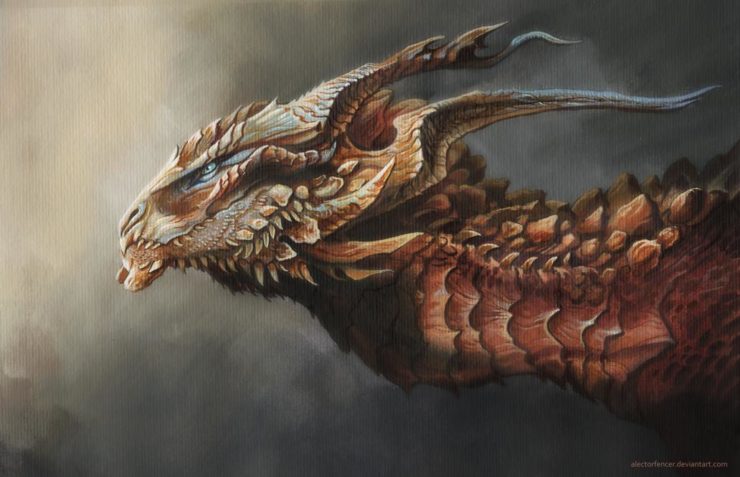
The origin of the dragon is such a mystery, even the exact etymology of its name is disputed. But you can mostly trace the meaning of dragon back to “serpent” (as with drakon in Ancient Greek and draco in Latin, for instance). If you dig deeper, its root derk- (or drk-) is the equivalent of “to see” in Ancient Greek—suggesting that drk-on also indicates “seeing one,” or “I see.”
Ironically, this power of sight was a one-way street: no one in the Western world could agree on what they saw of the dragon. As such, the earliest descriptions of them were fabulously inconsistent. Generally, dragons were titanic and powerful—but that was about where the common ground ended. Some accounts said that dragons were poisonous; others argued that they breathed fire; still others insisted that they were winged. In fact, if there was only one constant in ancient Western myths, it was this glaring certainty: dragons were stone-cold evil.
This speciest character assassination spanned the continent of Europe. In Greece, dragons were either monstrous beasts that stood in place to thwart protagonists from their heroic destinies (think Jason snatching the Golden Fleece from a dragon’s jaws), or public enemies to be overcome by gods and goddesses. Typhon, the father of all monsters, is defeated by Zeus; Python the serpent felled by Apollo; and Ladon, son of Typhon, dispatched by Heracles.
If you travel farther north, you’ll encounter the dragon Níðhöggr gnawing at the roots of Yggsdragil, the world tree of Norse mythology. To the south, the dragon-goddess Tiamat in Babylon is a symbol of the chaos of primordial creation: a “maelstrom of dark, roiling seawater” whose very death allows for the world to be born. But the most damning case against dragons comes from the Bible itself: in the Book of Revelation, Satan is said to descend upon the masses as (you guessed it) a great red dragon.
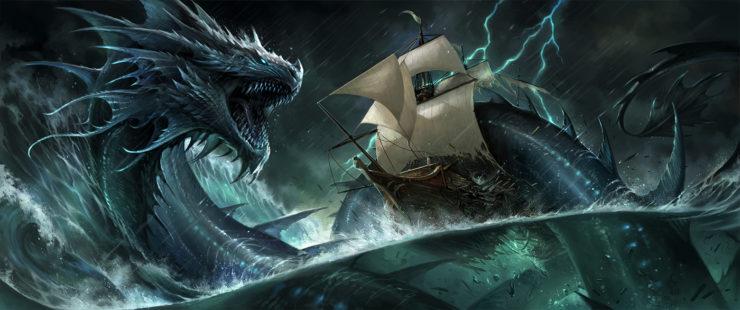
Such allegations would surely make any upstanding creature reel, but perhaps the last nail in the coffin was delivered by the earliest Latin bestiaries. Far from quelling society’s collective fears, they gaily fanned the flames. According to these works, dragons sat at the pinnacle of the zoological chain, and were incredibly wicked, shockingly vile… and very real to boot. Isidore of Seville wrote in Etymologiae:
The dragon is the largest of all the snakes, or of all the animals on earth. The Greeks call it Δράκων, whence the term is borrowed into Latin so that we say draco. It is often drawn out of caves and soars aloft, and disturbs the air. Even the elephant with his huge body is not safe from the dragon, for it lurks around the paths along which the elephants are accustomed to walk, and wraps around their legs in coils and kills them by suffocating them.
Then there was Hugh of Fouilloy, author of the famous Aviarium, who declared:
The dragon, the greatest of all serpents, is the devil, the king of all evil. As it deals death with its poisonous breath and blow of its tail, so the devil destroys men’s souls by thought, word, and deed.
If it was fake news, it was extremely convincing fake news, or so the people at the time probably thought. Eventually, the God-fearing public was tipped off that the dragon was really a mythical creature, not an actual, living, breathing monster come to Earth straight from Hell. But by that point the damage was done, and the battle lines were irrevocably drawn for millennia to come.
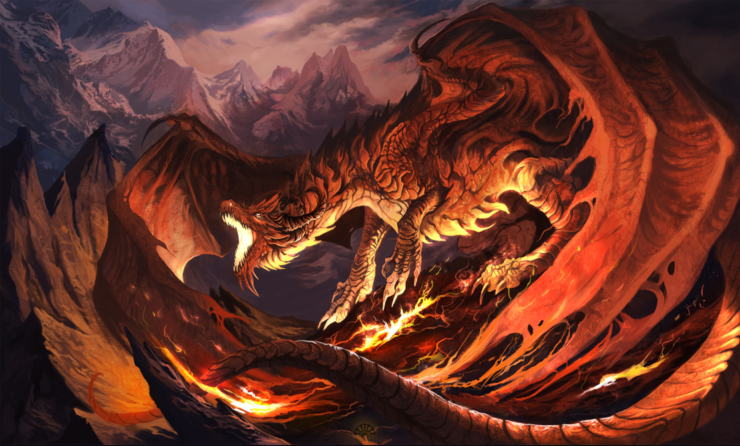
A Who’s Who of Major Dragons From This Era:
- Jörmungandr—The Midgard Serpent, or World Serpent, from Norse mythology. The arch-enemy of Thor, God of Thunder.
- Typhon—Commonly called the “father of all monsters” in Greek mythology. Had a hundred dragon heads sprouting from his shoulders, which must’ve been inconvenient in social situations.
- Ladon—The dragon who guarded the golden apples in the Garden of the Hesperides. Defeated by Hercules.
- Tiamat—The primordial dragon-goddess of the cosmos in Babylonian legend. Her death enables the Earth’s creation.
The Middle Ages to the Renaissance (1200 – 1600)
Due to the dragon’s reputation for swallowing villagers whole… and possibly breathing fire… and felling ancient world trees… and generally serving chaos and embodying evil, medieval folks were perhaps unsurprisingly keener on writing books titled How to Kill a Dragon than How to Train Your Dragon. In short, the dragon became typecast as the villain—one of the mightiest opponents that mankind could conceivably conquer.
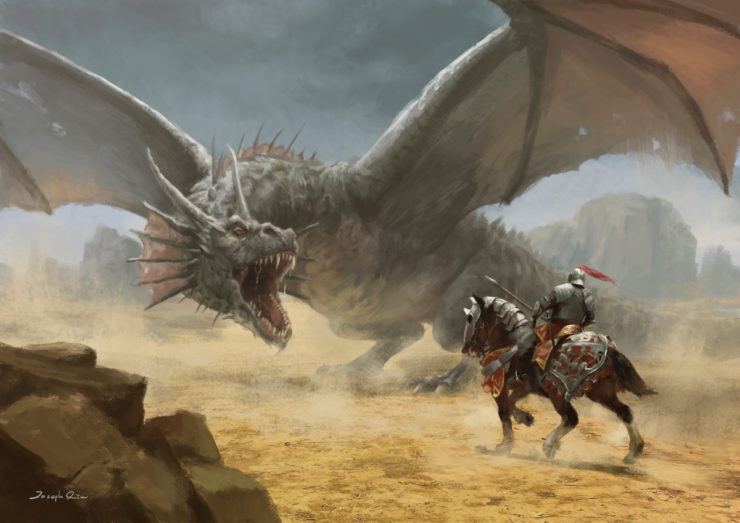
Errour from Edmund Spenser’s The Faerie Queen, Goji from medieval France, the Lambton Wyrm: such was the tally of dragons who fell in medieval and early modern Europe. But most dragons were nameless, footnotes in the ballads that were sung of brave men’s triumphs. In the 14th century’s Tale of Sir Eglamour of Artois, the dragon is Sir Eglamour’s ultimate—and most challenging—test. Sir Torrent of Portyngale ups this quota—Torrent gets to kill two dragons. Then you’ve got the dragons in Saint George and the Dragon and Tristan and Isolde, who meet identical grisly fates. Even the celebrated Knights of the Round Table get in on the action: in Thomas Malory’s Le Morte d’Arthur, Launcelot does epic battle with a massive, fire-breathing dragon in a tomb.
Each tale illuminated a certain pattern. The hero wins. The horse maybe dies. The dragon definitely dies.
This would be the template for a long time. And since one can’t kill this many a dragon without creating a few tropes, we see the fortification of several related motifs that soon would take flight in the public imagination: the maiden in need of rescue, the chivalric quest and climactic dragon-fight, and the castle.
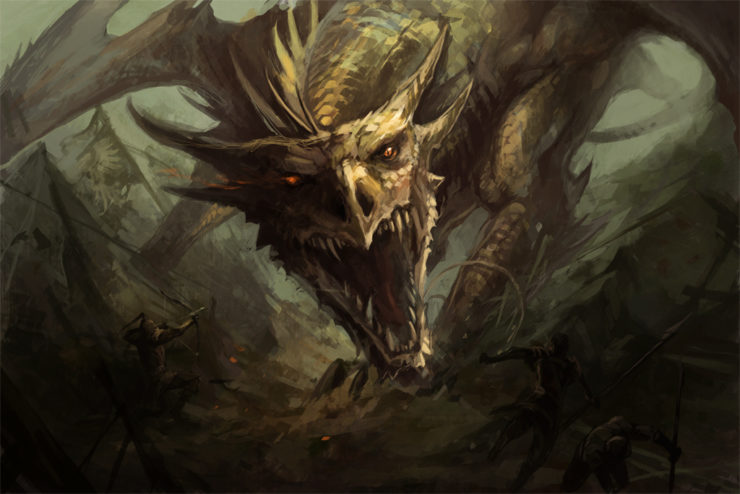
But a plot twist does transpire. The Middle Ages, an epoch that was basically a continual continent-wide massacre of dragons in western literature, would curiously give us two of the greatest dragons of all time. Today, Fáfnir from the Völsunga Saga and the unnamed dragon from Beowulf are central to draconic lore—not least because of the deep impression they made on the future grandmaster of fantasy. Said J.R.R. Tolkien in the 1938 lecture “On Fairy-Stories”:
Dragons, real dragons, essential to both the machinery and the ideas of a poem or tale, are actually rare. In northern literature, there are only two that are significant. If we omit from consideration the vast and vague Encircler of the World, Miðgarðsormr, the doom of the great gods and no matter for heroes, we have but the dragon of the Völsungs, Fáfnir, and Beowulf’s bane.
The two dragons would cast long shadows for centuries. Both set the benchmark for a dragon’s ferocity, might, and potential for destruction. Both perpetuated the tropes most closely entwined with the dragon, including fire and the greed for gold. And both forged the construct of the dragon-slayer, for both were slain by mortals: Sigurd and Beowulf, respectively.
Yet this wasn’t even the hardest trial at hand. In this age and all coming ages, the dragon still faced an even greater enemy: its own biblical ghost. To the people of the Middle Ages, it was Satan, plain and simple—and it deserved to be killed every time.
A Who’s Who of Major Dragons From This Era:
- Fáfnir—A man who became a great dragon because of his greed. Defeated by Sigurd.
- The Dragon from Beowulf—A terrible unnamed dragon from the Anglo-Saxon epic. The dragon-fight ends with the deaths of both Beowulf and the dragon.
- The Dragon from George and the Dragon—An unnamed dragon that was only appeased by human sacrifices. Dramatically defeated by St. George.
- Errour—A serpent-monster from Edmund Spenser’s The Faerie Queen. Defeated by the Redcrosse Knight.
The Shadow of Tolkien (Early 1900s)
Between 1700 and 1900, a number of things come to pass: The Age of Enlightenment dawns. The United States of America is created. The Ottoman Empire begins to fall. A thousand French cartoonists call Napoleon short. The first modern novel is written. Fantasy starts its rise as a genre. And dragons are pretty much nowhere to be seen in literature, so much so that May Dacre exclaims in Benjamin Disraeli’s 1831 The Young Duke, “The age of chivalry is past. Bores have succeeded to dragons.”
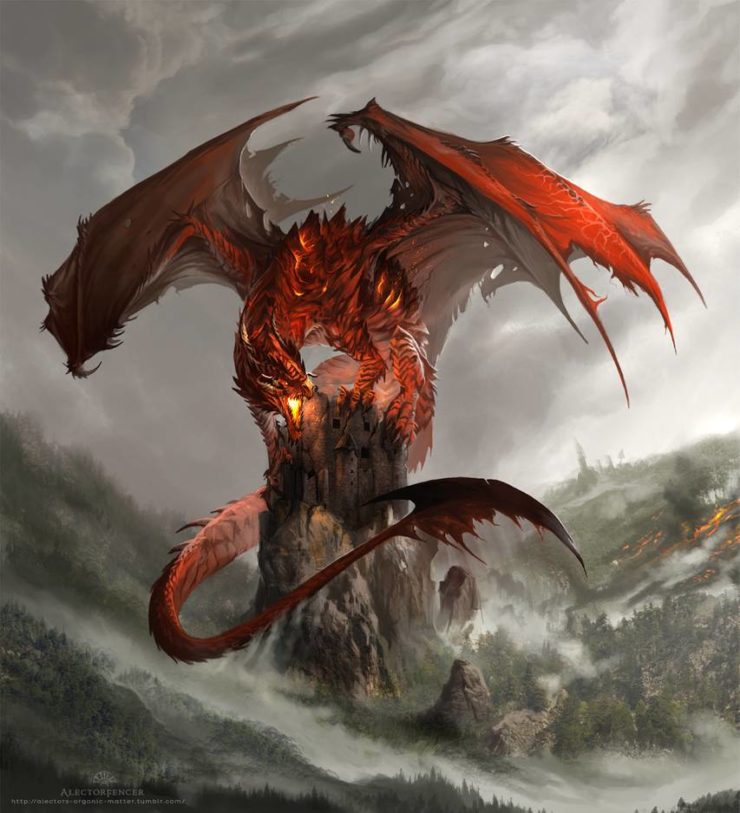
Why did writers in these centuries mostly, excuse the pun, wing it? According to critic Ruth Berman:
During the nineteenth century, fantasy became a genre, but the absence of dragons among the wealth of ghosts, witches, devils, mer-folk, fairies, etc., is striking. Monsters in general were rare, but dragons were much rarer. […] The reluctance to use dragons was probably a result of the too rigid identification of the dragon with the dragon of the Book of Revelations, that is, Satan.
It would take until the turn of the twentieth century for the dragon to find storytellers who dared to reach out and court whispers of blasphemy by resurrecting them: children’s authors, and (spoiler alert!) J.R.R. Tolkien. The former group of writers—always up to satirize and play with convention—can be credited with providing the first literary sandbox for playing with the idea of dragons. Case in point: Kenneth Grahame’s 1898 The Reluctant Dragon and E. Nesbit’s 1899 The Book of Dragons were among the earliest books to show benign, comic, and “good” dragons.
In stark contrast stood the dragons conjured by Tolkien, whose childhood dreams had always sought out the titanic, formidable dragons of old. He once said:
I desired dragons with a profound desire. Of course, I in my timid body did not wish to have them in the neighborhood. But the world that contained even the imagination of Fáfnir was richer and more beautiful, at whatever cost of peril.
The Lord of the Rings and The Silmarillion were the culmination of Tolkien’s soaring vision. The dragons of Middle-earth were majestic, fire-breathing, and terrifying, bearing a greater resemblance to Tolkien’s other terrible monsters, such as the blazing Balrog of Morgoth, than to the chummy dragons of children’s books. The DNA they share with Fáfnir and Beowulf’s dragon is unmistakable. Like their ancestors, Tolkien’s dragons possess tremendous antiquity. Like their ancestors, they are mighty and cunning, and they covet gold above all else. Even certain episodes from The Lord of the Rings seem to mirror scenes from the Völsunga Saga and Beowulf (Bilbo’s theft of a golden cup from Smaug in The Hobbit is clearly similar to the single cup that’s stolen from the dragon in Beowulf, for instance).
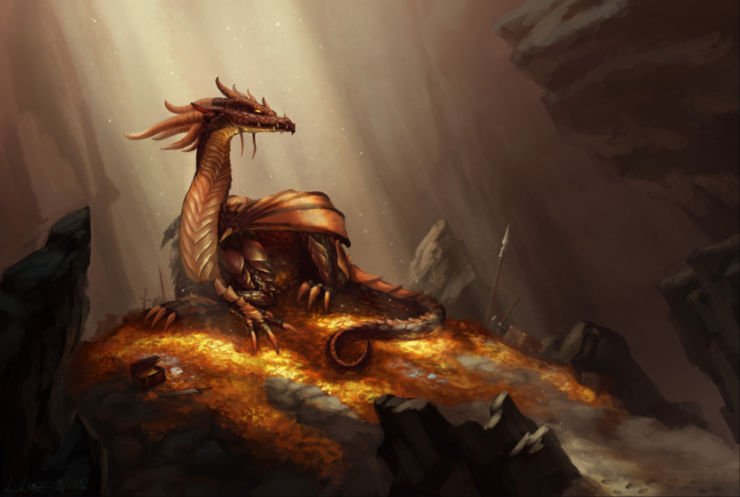
But Tolkien undertook a mission more complicated than just a simple revival of older traditions. Before him, dragons were evil and dangerous. With Tolkien, well, they were still evil and dangerous. But he also attempted to give his dragons “bestial life and thought of [their] own” (as he’d put it in his 1936 lecture “Beowulf: The Monsters and the Critics”). Tolkien saw Fáfnir’s early power of speech and raised it a satisfying sense of self, finally imparting this ancient species with the gift of a fully-formed mind and tongue. And so it’s a bit ironic that so much of the fantasy genre is made in Tolkien’s image—except for dragons. As that same lecture on Beowulf made clear, the father of fantasy had always considered draco “a personification of malice, greed, destruction, and of the undiscriminating cruelty of fortune that distinguishes not good or bad.”
In other words, the dragon’s redemption tale still couldn’t begin just yet: it would need to wait another couple of decades for the right authors to come along.
A Who’s Who of Major Dragons From This Era:
- Ancalagon the Black—The greatest of all Middle-earth’s winged dragons, according to The Silmarillion. His fiery death ended the First Age.
- Glaurung—The Father of Dragons in Middle-earth. Wingless, poisonous, and terrifying.
- Smaug the Golden—The last of Middle-Earth’s “great” dragons. Defeated by Bard the Bowman in the Third Age, as recounted in The Hobbit.
- The Dragon, from The Reluctant Dragon—A scholarly dragon who especially loves poetry, and is befriended by a young boy.
Women and the Rehabilitation of the Dragon (1950 – 1990)
So by the time we enter the 1950s, nothing’s changed too much. That swath of space on the map branded “Here Be Dragons” is still, for the most part, rather bleak. A few books appeared to fight the tide: for instance, 1948’s My Father’s Dragon, by Ruth Stiles Gannett, joins children’s books like The Book of Dragons and The Reluctant Dragon in depicting a “good” dragon. But we don’t see anything really moving the needle until two SFF authors, Anne McCaffrey and Ursula K. Le Guin, become ascendant in the 1960s.
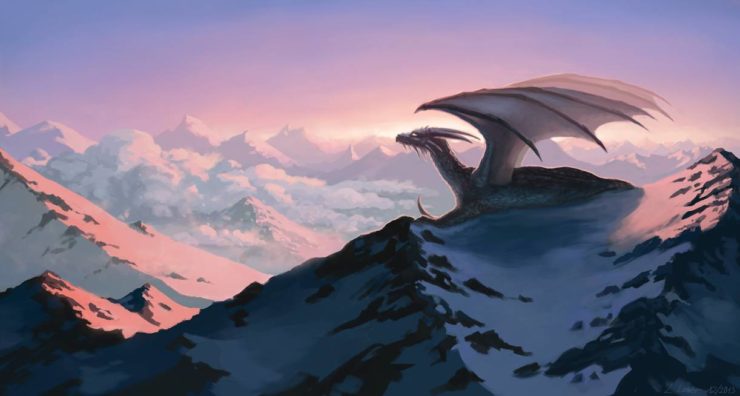
First, McCaffrey, the creator of Pern, stepped up to the plate—becoming perhaps the first Western adult fiction writer to definitively show the world that a dragon didn’t need to be evil just because it was a dragon. Her slim Weyr Search, first published in Analog in 1967, boasted feudal rulers, time travel, stolen birthrights. Most importantly, it featured telepathic dragon companions—capable of forming deep bonds with their dragon-riders (yet another mind-melting concept, at the time).
Delivering a one-two punch to the genre’s conventions, Ursula Le Guin published A Wizard of Earthsea soon afterward in 1968. Her importance in modern fantasy is today impossible to quantify. In January 2018, John Scalzi wrote in the Los Angeles Times that losing Le Guin was “like losing one of the great sequoias.” In another of the countless tributes made upon her death, Arnab Chakraborty asked, “What was her secret?”
It was merely this: you take a dragon (one of Le Guin’s most brilliant re-inventions). A dragon is that hoary old standard of fantasy, and this poor creature is now waiting on some clifftop, tired and exhausted at having been cast in so many tales and parables down the ages. He wants some rest, some well deserved shut-eye. But soon comes hobbling down the road an old woman with a twinkle in her eye, and she proceeds to sit down beside him. The dragon senses her presence, braces for yet another request to star in a quest, a razing of towns, a romance. But this woman merely wants to speak to someone at the end of her long journey uphill. Just that. And the dragon is, for once, asked about his views on the world. Just a conversation, really.
And perhaps that was exactly the route that Le Guin took to create four of the most magnificent dragons that we’ll ever encounter. To this day, Yevaud, Orm Embar, Kalessin, and Orm Irian are towering examples of all that dragons can be. As Hugo-nominated fantasy writer Max Gladstone said over at The Ranting Dragon:
Le Guin’s dragons set the gold standard. Ancient, wise, capricious, beautiful, mighty, and sometimes sad, she salts Tolkien’s profoundly Western dragons—for all his majesty, Smaug the Terrible is a clear descendant of the “St. George” and the species of dragon—with elements of the Chinese demigod. […] While Le Guin’s fingerprints on the genre are subtler than Tolkien’s, I don’t think we would have the modern fantasy dragon—subtle, cunning, alien, wrathful and compassionate all at once—without her work. Seraphina and Temeraire owe a great deal to Orm Embar.

Extraordinarily, Le Guin’s and McCaffrey’s dragons were moreover so shockingly distinct that they created two strapping draconic lineages in fantasy, going forward. As John Lennard observes in Of Modern Dragons, Pernese dragons “[reverse] all the Beowulfian tropes while preserving the winged and fiery reptilian form.” In stark contrast, Earthsea’s dragons retain shades of Fáfnir and Smaug, most markedly in their marvelous linguistic faculties. The incongruities run deeper: Pernese dragons are decidedly moral and “good.” Earthsea’s dragons are neither good nor evil, but rather unpredictable, unmoved by the squabbles of mere mortals, and frighteningly unknowable. Pernese dragons are relatively young, not being around when Pern was created. Earthsea’s dragons are as ancient as Earthsea itself.
Pernese dragons, in other words, are tamed comrades. Earthsea’s dragons are demi-gods.
But it’s the one commonality they did share that really matters. Little did McCaffrey or Le Guin realize the extent of the draconic activity that their dragons would trigger over the next few decades (including such amazing examples as Michael Ende’s The Neverending Story in 1979, Robert Munsch’s The Paper Bag Princess in 1980, Terry Pratchett’s gleefully irreverent Draco Nobilis and Draco Vulgaris species in Discworld in the 1980s, and Tracy Hickman and Margaret Weis’ Dragonlance series in 1984! And that’s just to name a few). If not for McCaffrey and Le Guin, today’s awesome and diverse dragons might be DOA (Dead On Arrival, or perhaps Dragons Overtly Absent). And our world would be that much poorer for it.
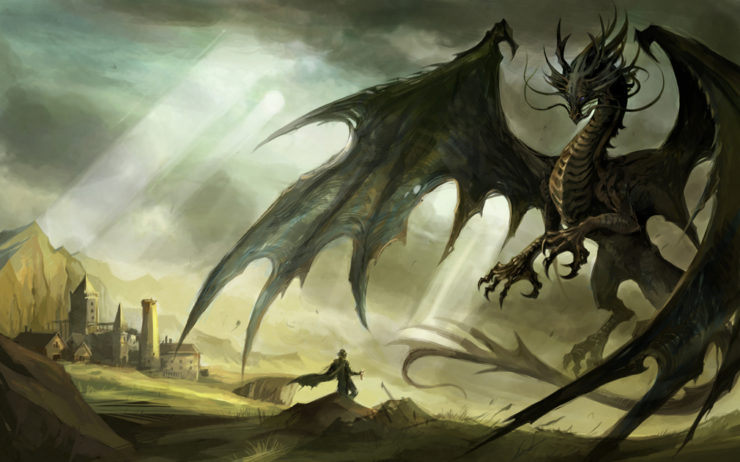
Looking back now, the dragon’s redemption tale might seem inevitable, but it really wasn’t a sure thing, by any means. That uncharted territory on the map marked “Here Be Dragons” was more powerfully emblematic than anyone could’ve guessed. After generations of writers had either vilified or outright ignored that spot of land, two women finally ventured forth into it and made the fateful decision to choose the road not taken, thank you very much—toppling millennia of unexamined preconceptions and prejudice against dragons in the process.
A Who’s Who of Major Dragons From This Era:
- Yevaud—The Dragon of Pendor in the world of Earthsea. First appears in the 1964 short story “The Rule of Names.”
- Orm Irian—The dragon-daughter of Kalessin the Eldest who can turn into a woman at will. First appears in Earthsea’s The Other Wind.
- Ramoth—The golden dragon-queen during the Eight Interval and Ninth Pass in Dragonriders of Pern. Her rider was Lessa.
- The Jabberwock—The eponymous dragon of Lewis Carroll’s “Jabberwocky” nonsense poem, and winner (or perhaps loser) of the best dragon name…and there are certainly a lot to choose from.
- Falkor—A luckdragon who plays a major role in Michael Ende’s 1979 The Neverending Story. Befriends Atreyu, a boy warrior.
- Eustace Scrubb—A young boy (“There was a boy called Eustace Clarence Scrubb, and he almost deserved it”) from The Voyage of the Dawn Treader. Temporarily turned into a dragon through his own unchecked greed.
Here Be Dragons (1990s – Present)
You’re probably already well aware of the dragon’s rock star status in popular culture today. Unless you’ve been sequestered underneath an extremely large rock for the last couple of decades, it’s tough not to notice that dragons are pretty much everywhere: from the silver screen (How to Train Your Dragon, Pete’s Dragon, Mulan, and, of course, Peter Jackson’s three Hobbit movies, among others) and television (HBO’s Game of Thrones) to games (Spyro, Warcraft, Final Fantasy, Skyrim).
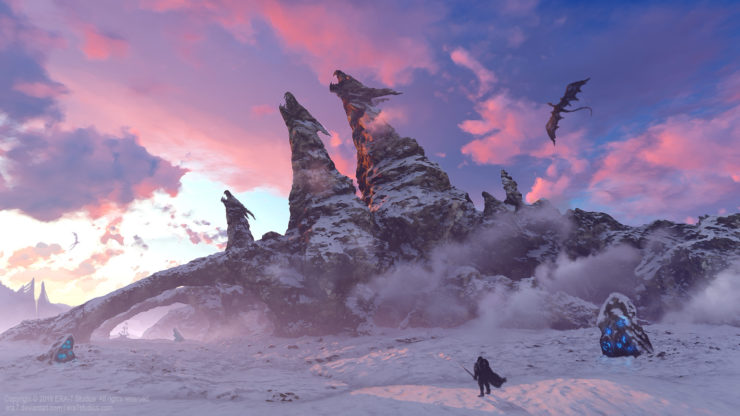
And in books? We can’t seem to get enough. Temeraire, Drogon, Saphira: today’s crop of complex, multi-dimensional dragons are basically minor celebrities in fantasy and science fiction. In them we can still see echoes of the dragons that came before. (Temeraire, for instance, is probably a nearer descendant of Ramoth than that great and malicious beast of yesteryear, Fáfnir.) Yet this generation is also coming up with new ways to shape the great, ongoing draconic narrative. Epic fantasies such as Game of Thrones present dragons as wild beasts that can nevertheless be befriended and bonded with (at least by some), while other works such as Marie Brennan’s Lady Trent series and Elizabeth Peters’ Summer of the Dragon explore dragons from a naturalist’s perspective.
It admittedly took us millennia to move past ingrained superstition and begin to reconsider the role of the dragon in storytelling. And yet the joke’s on us: in the time that it took for us to start reshaping the dragon in Western literature, the dragon was busy reshaping the very terrain of our own imaginations. Critic David E. Jones argues that humans have always had an “instinct for dragons” (in fact, it’s the title of his book on the subject). And in an essay for Abe Books, author Beth Carswell writes:
It’s fascinating that humans have not only created the fictional, mythical creature of the dragon, but also repeatedly adhered to recurring archetypes around it—where there is a dragon, one can almost always expect to find any or all of the following: gnomes, dwarves, castles, knights, princesses, trolls, goblins or treasure. We have created not only a magnificent animal from thin air, but also entire landscapes to support its legend.
So where do dragons go now in Western literature? Given all the twists and turns that their story’s taken over the centuries, it might be impossible to predict. But this much at least should be certain: they’re not going to go away. Dragons have already come with us this far: looming large in our legends since antiquity, wheeling in the skies as European knights came and went, rising to new heights as fantasy really took flight in the last century—and they’ll hopefully stick around, soaring through our literary future, continuing to test our sheer capacity for wonder. There is, after all, that maxim that Le Guin relates in her introduction to Tales of Earthsea: “Nobody can explain a dragon.” Luckily for us, authors of every age have never stopped trying.

A Who’s Who of Major Dragons From This Era:
- Temeraire—A rare Chinese Celestial dragon born during the Napoleonic wars. Bonds with Captain William Laurence in Naomi Novak’s Temeraire series.
- Drogon—One of Daenerys Targaryen’s three dragons in George R.R. Martin’s A Song of Ice and Fire. Huge and black, with a wingspan of twenty feet as of A Dance with Dragons.
- Saphira—Eragon’s dragon from Christopher Paolini’s Inheritance Cycle. One of the last female dragons in Alagaësia.
- Toothless—Hiccup Horrendous Haddock III’s dragon in Cressida Cowell’s How to Train Your Dragon. Commonly mistaken for a Common or Garden dragon.
- Villentretenmerth—One of only two Golden dragons in the history of the world of The Witcher; able to assume many forms through polymorphism. In Common Speech, his name means Three Black Birds.
Yvonne Shiau is a writer who enjoys walking through mountains. She is currently based in South America.










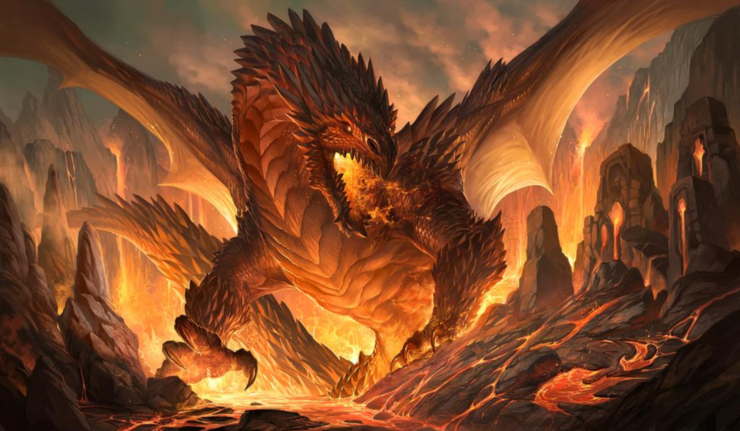
I wish this comment could do justice to the beautiful article you have written. Dragons are my favourite.
This is indeed a beautiful and fascinating essay. I wonder, where does the role-playing game of Dungeons & Dragons fit in? It tried to codify the various types of dragons – I can’t help but think that many modern fantasy authors were at least partially influenced by it…
I’ve always loved dragons! I enjoyed every word of this post ^^
Recently the dragons that have made an impression on me are the hordes of The Nameless One in “Priory of the Orange Tree” and the Old Man from “The Ruin of Kings”
Will there be another post for their Eastern counterparts? :)
Terrific article! You clearly spent a lot of time researching this, and I applaud you for it. I will definitely look out for more of your work in the future!
I’d like to call attention to a third woman who figured heavily in the development of the modern dragon, R.A. MacAvoy, author of Tea with the Black Dragon.
Now, some may say that Mayland Long is actually a Chinese dragon, but given his treatment and the story, he has to count as, at least, a naturalized immigrant. And any story that features Dr. Dobb’s Journal of Computer Calisthenics & Orthodontia (I had a subscription) as an important resource, has to count as a piece of Western literature.
Awesome.
Fuchur (that’s his real name, not Falkor) is an eastern dragon. Another of Ende’s books, Jim Knopf, has a dragon (Frau Mahlzahn) who turns from an evil western dragon into a good eastern dragon.
Other children’s stories also have nice dragons like Grisù, the little dragon who wants to become a firefighter but often accidentally sets fires, or Tabaluga, who was invented by a musician.
The dragonology series pretends to be nonfiction books about how to study dragons for children.
I love this. Dragons are one of my favorite things about fantasy literature. But where is the mention for Gordon R Dickson’s Dragon series? “The Dragon and the George” and the subsequent books were some if my absolute favorites.
Don’t forget Patricia Wrede and the Enchanted Forest Chronicles. The first is called Dealing with Dragons described as follows Bored with traditional palace life, a princess goes off to live with a group of dragons and soon becomes involved with fighting against some disreputable wizards who want to steal away the dragons’ kingdom . They’re are great fun and there is at least 4 or 5 in the series. Jane Yolen has a couple of different dragon books. Last but not least is on of my all time favorite books turned animated movie by Peter Dickinson A Flight of Dragons.
@2:
There is no doubt that D&D, as well as its Dragonlance spinoff, are at least as influential over the thoughts of Dragons in both literature and culture today as anything else listed in this article.
How can you not mention the great Robin Hobb ?
Really interesting
Among the mythological dragons is the Sirrush of the Ishtar Gate (or Mushkhushshu – https://en.wikipedia.org/wiki/Mu%C5%A1%E1%B8%ABu%C5%A1%C5%A1u) which some believe made it into the Bible (Book of Daniel 14: 23-42).
For that matter, doesn’t the biblical Leviathan count as a dragon from the Age of Myth?
Adrienne Major (https://en.wikipedia.org/wiki/Adrienne_Mayor) wrote a good book on how Classical-age Greeks interpreted fossil bones of extinct giant mammals as being the remains of giants and dragons. On the subject of the Greeks, Perseus fought a giant marine dragon in his rescue of Andromeda. And Scylla was a dragon, possibly related to the Hydra due to a certain superfluity of heads.
Thank you for all your research on this :) This was a fun romp!
I find that I tend to think of dragons, if not the evil variety, in the ‘above it all’ camp – mysterious, ancient, and wise, and possibly above mortal concerns. Even if they’re friendly, they’re still…other (in a good way).
Interesting Piece!
I think a missed opportunity in looking at Dragons in the future, referencing the capitalist, empire building dragons of ShadowRun, or their usage in, say, Peter Hamilton’s work.
“Ancient, wise, capricious, beautiful, mighty, and sometimes sad, she…”
Best dangling participle ever. Le Guin may have been all those things, but I don’t think that’s what Max Gladstone invented.
A great article. I have much reading and re-reading to do.
This is a lovely article. Just one niggle – Beowulf’s dragon is very dramatically in the wrong era. Admittedly the dating of Beowulf is a problem, but there’s just no way it’s after 1200. The manuscript almost certainly dates to the early 1000s.
( https://www.bl.uk/collection-items/beowulf )
The date of the poem is a real puzzle that’s unlikely to be definitely solved. It’s a while since I studied Beowulf, but the scholarly consensus seems to favour a link with the court of Alfred around the 890s – while acknowledging that the material could well be much older, as could the poem itself.
( https://www.oxfordhandbooks.com/view/10.1093/oxfordhb/9780199935338.001.0001/oxfordhb-9780199935338-e-006 )
In any case, it’s a lot earlier than 1200!
@16/David Evans: You don’t think that Max Gladstone invented Le Guin?
Great read!
Interesting to note that the Red Dragon of the Welsh seems then to be somewhat of an outlier in Western mythology – a symbol of Welsh national pride & spirit (even rebellion) that in turn adorns the best flag ;)
Echoing all the others, this really was a great read. Extremely interesting, extremely beautiful, and with extremely gorgeous illustrations picked to accompany it. Thank you for this treat!
Missed opportunity of typing one of the greatest dragon names ever: Vermithrax Pejorative.
Great article, but how could you miss Trogdor? Those Vs were… consummate!
@23 – this just brought back a blast from the past.
Possibly worth adding to the final part of this piece is Sir Kazuo Ishiguro’s “Querig” from his novel “The Buried Giant”. Querig is believed to be the source of the mist that causes the continuous memory loss of inhabitants in the region; I’ll not spoil the truth of it, but it’s worth reading if you haven’t.
I’ve wanted to read a history of dragons in Western lit for a long while now, and this article gave me everything I wanted. I love it!
If you want a truly modern “mother of dragons” there is Bethesda Heartstriker. The hard hearted Mother of a seveal hundred dragons in Rachel Arron’s Heartstriker series that features Julius who is a nice dragon much to Bethesda’s disgust. The series starts with Nice Dragons Finish Last.
I am a dragon enthusiast and I loved this article. Excellent summary of the history and evolution of Western dragons. I notice that Barbara Hambly wasn’t mentioned. Barbara Hambly’s dragons in the Dragonsbane series which came out in the 1980s-1990s followed in the footsteps of Ursula K. Le Guin. The first book in the series, the dragons are presented as beasts to be slain but it quickly becomes apparent that they are ancient beings who are sentient and wise and other, not the mindless evil beasts of legend. I was raised on MaCaffrey and Le Guin, but Hambly’s dragons hold a place in my heart, especially Morkeleb the Black.
I noticed that the article didn’t even touch on the juggernaut that is modern paranormal romance with dragon shifters. :)
Thanks for the wonderful overview, Yvonne. I prefer the LeGuin dragons, just like I prefer Banks’s spaceships of the Culture. Wise, mysterious, and sometimes curiously benevolent, combined they are the greatest symbol of SF/F. Whenever someone asks me if I’ve read so-and-so book, my response is always, “Does it have dragons or spaceships in it?” as a shortcut to if it’s not SF/F, I’m not interested.
@20: Agree, the Welsh flag is the best flag!
@23: Excellent shout out for Trogdor the Burninator! Strongbad still gives the best Dragon Drawing Lesson
You’ve got the Jabberwock severely misplaced…
Daniel Arenson’s world of Requiem spans 7 trilogies (so far) and around 3,000 years of history (so far) since the appearance of a new constellation in the sky over Requiem.
The first trilogy chronologically wasn’t the first one written. It starts when the constellation appeared and suddenly some people could transform themselves into dragons. This is in a late stone to early metal age era.
The history shifts a few times among dragons being hunted by normal humans, to the two living somewhat peacefully, to dragons ascendant. At times one or the other is nearly hunted to extinction. By the 6th trilogy the technology level has finally gotten around to primitive firearms. I haven’t read the 7th trilogy yet.
Then there’s this “docufiction” presentation. https://en.wikipedia.org/wiki/The_Last_Dragon_(2004_film)
I love dragons in stories! I often wondered why there weren’t more in LotR after Smaug in The Hobbit.
One of my favorites is Jezza the dragon who plays with a football in Demoniac Dance by Jaq D. Hawkins. The dragons in the battle in that one were awesome!
Re; #20
I was about to referece Y Ddraig Goch! (Welsh soft mutates, so the dragon is female!).
She is definitely a positive figure.
@20 dawfydd: I agree, the Welsh flag is awesome – iconic even but not literature which is what this article was about. Never mind you still have “Tecwyn: the last Welsh dragon” by Mary Dawson. My kids loved it. Interesting concept for the time but now might be considered proper gander for nuclear power.
The first Tolkien I read, in the 50s, was Farmer Giles of Ham, which featured the dragon Chrysophylax.
Although not so much characters as forces of nature, when I think of more recent literary dragons I always think of Anne McCaffery first, but Melanie Rawn second. Her Dragon Prince and Dragon Star trilogies are certainly worth a read.
Huh! Had never thought of Smaug as inventing the clever, spellbinding, dragon. (Also Glaurung, for any post-1977 authors who read the Silmarillion.) Given that Fafnir was a dwarf (or giant) turned dragon, Smaug might be the first intelligent “true dragon” in the West! That feels weird.
It occurs to me that an earlier appearance of the “dragon as companion, especially for riding”, one that predates Anne McCaffrey, might be the dragons of Melniboné in Michael Moorcock’s Elric stories, which date to the early 1960s.
Rakos @@@@@ 13:
Adrienne Major (https://en.wikipedia.org/wiki/Adrienne_Mayor) wrote a good book on how Classical-age Greeks interpreted fossil bones of extinct giant mammals as being the remains of giants and dragons.
It’s a neat idea, but the paleontologist (and artist) Mark Witton is very skeptical of the “Protoceratops fossils inspired Greek griffins” part of that; see here. (Basically, Greek griffins are clearly based on millennia of earlier Near Eastern griffins, which are clearly chimerae combining the features of lions and birds.)
I’ve always loved dragons! I enjoyed every word of this post. It is difficult and time consuming to do search research, hats down.
Will there be another post for their Eastern counterparts? :)
I love the powerful Zmey and all stories associated with this creature from Bulgarian Mythology.
I read The Unborn Hero from Dragon village by Ronesa Aveela and it was fascinating.
Thank you for a wonderful article:)).
Thanks for this lovely story.
I would call out the British Cymric tradition of naming clan chief’s dragons:
“dragon; warrior“; borrowed from the Latin word dracō, plural dracōnēs, “dragon[s]”) literally means “Chief-Dragon” or “Head-Dragon”, but in a figurative sense, “chief leader”, “chief of warriors”, “commander-in-chief”, “generalissimo”, or “chief governor”. [https://en.wikipedia.org/wiki/Uther_Pendragon] This gives us Uther Pendragon, and the Welsh Red Dragon.
I also have to echo the comment that Moorcock had dragon companions of neither good nor evil in his Elric books before or perhaps co-inciding with Pern.
I loved this article!
It shows how through the ages the dragon has evolved from being a representation of something that can be fought with brute strength – to something that needs both mental and physical acuity to best…
definitely looking forward to an analysis on the Eastern myths of dragons
and of course – as Goddessimho mentioned (@@@@@ 27) – Rachel Aaron’s Heartstrikers series has all the dragons you could possibly want – from greedy and captivating to brutish and thuggish – from the sly and calculating to the earnest and helpful!
If you’re talking about dragons in RPGs, I especially like the ones in Castle Falkenstein.
I absolutely loved “Tea With The Black Dragon”, which I read not too long after moving to pre-Internet-boom Silicon Valley and finding the book in one of the three used book stores we had in town then. It was a good, friendly book that also captured the spirit of the time.
Some other Chinese dragons who’ve visited Western science fiction include the ones in Tom Holt’s comedy “Nothing But Blue Skies” and Genevieve Cogman’s “The Invisible Library” series.